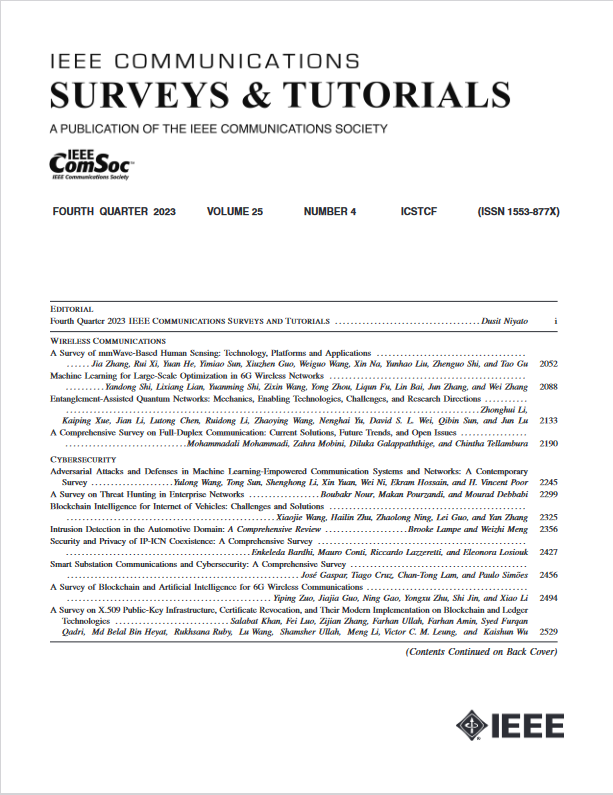结合联邦学习和边缘计算实现6G网络无处不在的智能:挑战、最新进展和未来方向
IF 34.4
1区 计算机科学
Q1 COMPUTER SCIENCE, INFORMATION SYSTEMS
引用次数: 0
摘要
充分利用大量用户设备产生的海量数据,在6G网络中提供智能服务,需要普适智能(Ubiquitous Intelligence, UI)。开发UI的关键在于大量网络设备的参与,这些设备将其数据贡献给协作机器学习(ML),并提供其计算资源来支持学习过程。联邦学习(FL)是一种新的机器学习方法,它使数据所有者能够在不暴露私有数据的情况下协作进行模型训练,从而允许用户设备将其数据贡献给开发UI。边缘计算在网络边缘部署了类似云的能力,使网络设备能够提供自己的计算资源来支持FL。因此,FL和边缘计算的结合将极大地促进6G网络中泛在智能的发展。在本文中,我们对FL和边缘计算结合技术的最新发展进行了全面的调查,并对FL和边缘计算领域进行了全面的展望。我们从部署在边缘计算环境中的FL框架(FL in edge)和为FL提供平台的边缘计算系统(edge for FL)的角度进行调查。从边缘计算中的FL角度来看,我们首先确定了边缘计算中FL的主要挑战,然后调查了解决这些挑战的代表性技术策略。从FL的边缘角度来看,我们首先分析了支持FL的边缘计算的关键要求,然后回顾了可能被利用来满足要求的边缘计算技术的最新进展。然后,我们讨论了一些开放的问题,并确定了将FL和边缘计算结合起来的未来研究的一些可能方向,希望引起研究界对这个新兴的、令人兴奋的跨学科领域的兴趣。本文章由计算机程序翻译,如有差异,请以英文原文为准。
Combining Federated Learning and Edge Computing Toward Ubiquitous Intelligence in 6G Network: Challenges, Recent Advances, and Future Directions
Full leverage of the huge volume of data generated on a large number of user devices for providing intelligent services in the 6G network calls for Ubiquitous Intelligence (UI). A key to developing UI lies in the involvement of the large number of network devices, which contribute their data to collaborative Machine Learning (ML) and provide their computational resources to support the learning process. Federated Learning (FL) is a new ML method that enables data owners to collaborate in model training without exposing private data, which allows user devices to contribute their data to developing UI. Edge computing deploys cloud-like capabilities at the network edge, which enables network devices to offer their computational resources for supporting FL. Therefore, a combination of FL and edge computing may greatly facilitate the development of ubiquitous intelligence in the 6G network. In this article, we present a comprehensive survey of the recent developments in technologies for combining FL and edge computing with a holistic vision across the fields of FL and edge computing. We conduct our survey from both the perspective of an FL framework deployed in an edge computing environment (FL in Edge) and the perspective of an edge computing system providing a platform for FL (Edge for FL). From the FL in Edge perspective, we first identify the main challenges to FL in edge computing and then survey the representative technical strategies for addressing the challenges. From the Edge for FL perspective, we first analyze the key requirements for edge computing to support FL and then review the recent advances in edge computing technologies that may be exploited to meet the requirements. Then we discuss open problems and identify some possible directions for future research on combining FL and edge computing, with the hope of arousing the research community’s interest in this emerging and exciting interdisciplinary field.
求助全文
通过发布文献求助,成功后即可免费获取论文全文。
去求助
来源期刊

IEEE Communications Surveys and Tutorials
COMPUTER SCIENCE, INFORMATION SYSTEMS-TELECOMMUNICATIONS
CiteScore
80.20
自引率
2.50%
发文量
84
审稿时长
6 months
期刊介绍:
IEEE Communications Surveys & Tutorials is an online journal published by the IEEE Communications Society for tutorials and surveys covering all aspects of the communications field. Telecommunications technology is progressing at a rapid pace, and the IEEE Communications Society is committed to providing researchers and other professionals the information and tools to stay abreast. IEEE Communications Surveys and Tutorials focuses on integrating and adding understanding to the existing literature on communications, putting results in context. Whether searching for in-depth information about a familiar area or an introduction into a new area, IEEE Communications Surveys & Tutorials aims to be the premier source of peer-reviewed, comprehensive tutorials and surveys, and pointers to further sources. IEEE Communications Surveys & Tutorials publishes only articles exclusively written for IEEE Communications Surveys & Tutorials and go through a rigorous review process before their publication in the quarterly issues.
A tutorial article in the IEEE Communications Surveys & Tutorials should be designed to help the reader to become familiar with and learn something specific about a chosen topic. In contrast, the term survey, as applied here, is defined to mean a survey of the literature. A survey article in IEEE Communications Surveys & Tutorials should provide a comprehensive review of developments in a selected area, covering its development from its inception to its current state and beyond, and illustrating its development through liberal citations from the literature. Both tutorials and surveys should be tutorial in nature and should be written in a style comprehensible to readers outside the specialty of the article.
 求助内容:
求助内容: 应助结果提醒方式:
应助结果提醒方式:


